Bob Bradley and his LAFC took the MLS by storm last year. Playing an exhilarating style of football, Bradley’s Los Angeles scored 85 goals and conceded a meagre 37 – the best offence and meanest defence in the whole of MLS.
While they missed out on winning the MLS, the 32-52 will go down in MLS history as one of the best teams. The key behind their success, which goes without saying, is Bradley himself. However, his stint at Swansea City was marred with inconsistency and defeats. His record at Swansea City had the club conceding 29 goals in 11 games – the most goals conceded by any PL club in that period of time – and only picking up 0.73 points per game.
So what has been Bradley’s philosophy at LAFC that has led him and his team to success?
In this head coach tactical analysis, we analyse the different tactics used by Los Angeles manager Bob Bradley. We will do an analysis of LAFC’s playing styles and provide you with an in-depth report into Bradley’s principles.
Lineups
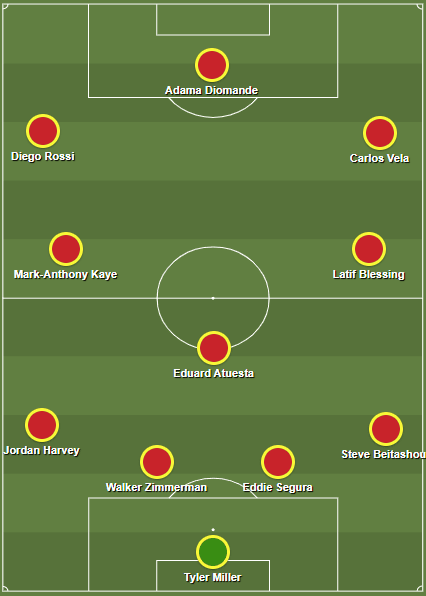
The normal formation for LAFC was 4-3-3 under Bob Bradley. Tyler Miller occupied the goalkeeper position while Steve Beitashour, Walker Zimmerman, Eddie Segura, and Jordan Harvey formed the defensive line.
Eduard Atuesta occupied the lone central defensive midfielder role while Latif Blessing and
Mark-Anthony Kaye occupying the other central midfield spots. In the attack, Carlos Vela would function as the left-winger while Adama Diomande would play striker and Diego Rossi would play right-winger, completing LAFC’s attacking trident.
Bradley’s offensive principles in open play
LAFC’s first team, and for that matter any player, is well-versed in technical abilities. It should be no surprise that LAFC play a possession-based system, one that is fluid while at the same time structured. In a possession-based system, the build-up is certainly important, but it is the open play where teams get to fully exercise the possession-based tactics.
In these matters, LAFC outshine their opponents brightly. This is evidenced by the fact that the 32-52 scored 69 goals from open play – the most in the league. The closest competitor was New York City FC who scored 49.
Bradley has structured LAFC’s attack on a basic principle: exploit the wings through centre-play.
Bradley first accomplishes this by having very loosely defined positions for the front three of LAFC. Normally, LAFC’s front three looks to be Vela, Diomande, and Rossi with Brian Rodríguez making starts here and there.
In terms of profile, all three attackers are very direct, fast, and certainly like to take on their man. Vela attempts 4.9 dribbles a game while Rossi attempts a similar 4.1 dribbles per game. Diomande, the lesser of the three, attempts 2.4 dribbles. As such, these forwards are very direct.
Couple a fierce trident with one of the most creative forwards from Mexico and you have a very industrious yet creative front-three that are constantly driving and trying something new.
However, the positions of the trident of LAFC are very loosely defined. Diomande is not a strict forward and neither Rossi and Vela are traditional wingers. This means that the defence really has no set defence marking system on the front three.
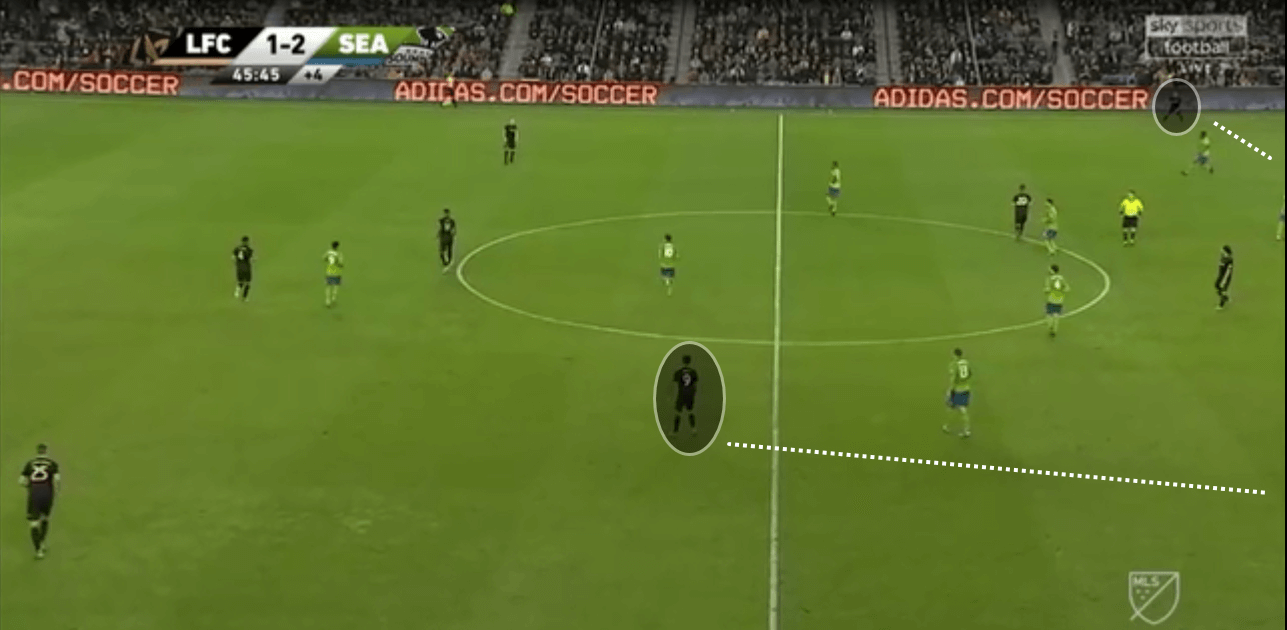
Here we see Rossi drop as deep as the midfield line whereas one of the other LAFC forwards goes all the way to the touchline. This shows just how flexible and free-flowing Bradley allows his forwards to be.
This fact, and their free movement, allows LAFC to have the liberty to drop one or two forwards in the centre-space. Since LAFC are not a traditional target-man team and they have the technical abilities to withstand press, the forwards are afforded the liberty to drop down as they please.
This creates numerical problems in the centre. With one, at times two, forwards dropping deep, the midfield of the opposition team is often left helpless as LAFC create 6v5 or 7v4 scenarios in the centre of the pitch. It is no surprise that 42% of LAFC’s action occurs in the centre of the pitch.
Bundled with a numerical superiority tactic, Bradley also utilises positional play to unite the two. The main members in the positional play for Bradley is the midfield. Blessing, Kaye, and Atuesta have all key components – each one suiting to their profiles.
Blessing is a strong carrier of the ball and key in maintaining the intensity. Kaye is the more attacking midfielder while Atuesta functions as the lone central defensive-midfielder.
In open play, the Atuesta sits deeper, all the while moving about the pitch, and recycling possession when attacks do not work out. Both Kaye and Blessing are put into the half-spaces. This positioning puts them at a short distance to the wingers while maintaining distance to the defence.
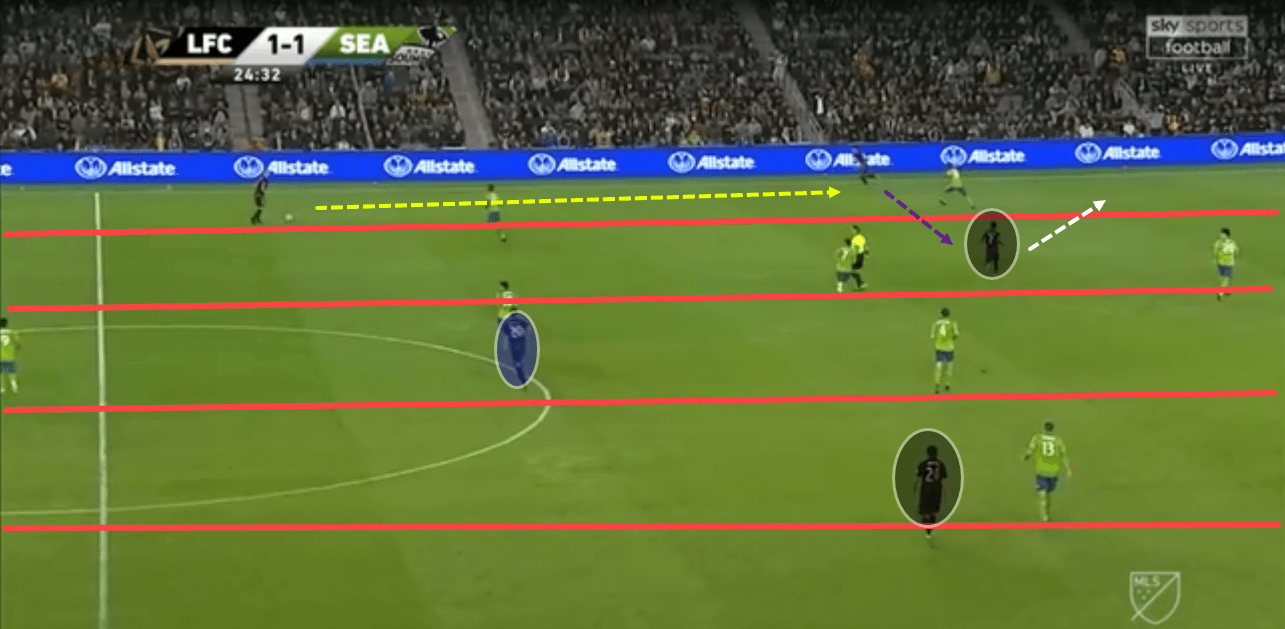
Here we see two of LAFC’s central midfielders in the halfspace – in black – which is designated by the red lines. Note how this positioning links up the full-back, the winger, and the midfielder. Moreover, it also allows LAFC to pass vertically and attack directly. The pass from the full-back meets the winger who can pass to the midfielder.
From here, the midfielder can exploit the wing areas where advantageous situations can be there for LAFC’s attacks.
As such, whenever the forwards drop deep, overloads in the centre are created easily. However, due to the positioning of the midfielders, LAFC are able to continuously create overloads on the wings. The midfield as such allows LAFC to pass the ball into the pockets of spaces in between the lines.
When the midfield positionings and the fluid forward movement synthesize, “organised chaos” occurs. Whenever LAFC bring the ball to the centre of the pitch, forwards will drop between the lines whereas the midfield players start to move to find the spaces between a shifting defence.
With the team drawn inwards and attention being focused inwards, 32-52 are able to find the runs of the full-backs and wingers with ease.
In the end, LAFC are able to stretch the defence and find 1v1 scenarios or scenarios where a cut-back or low cross can occur. Either way, LAFC always find a way to wriggle through the centre to attack the final third with incision, intelligence, and intuition.
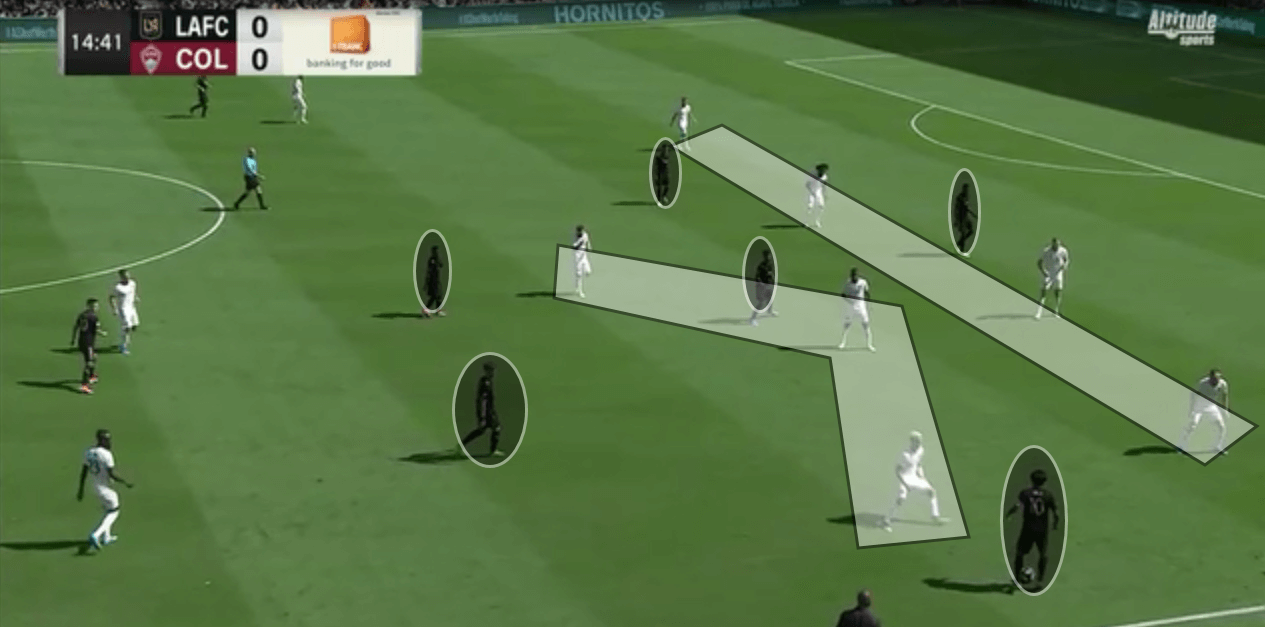
Here we see the opposition team’s disciplined formation. We also see LAFC’s player’s positions with Vela in the bottom right. We will see how Bradley’s attacking coaching allows LAFC to break this defence down in simple moves.
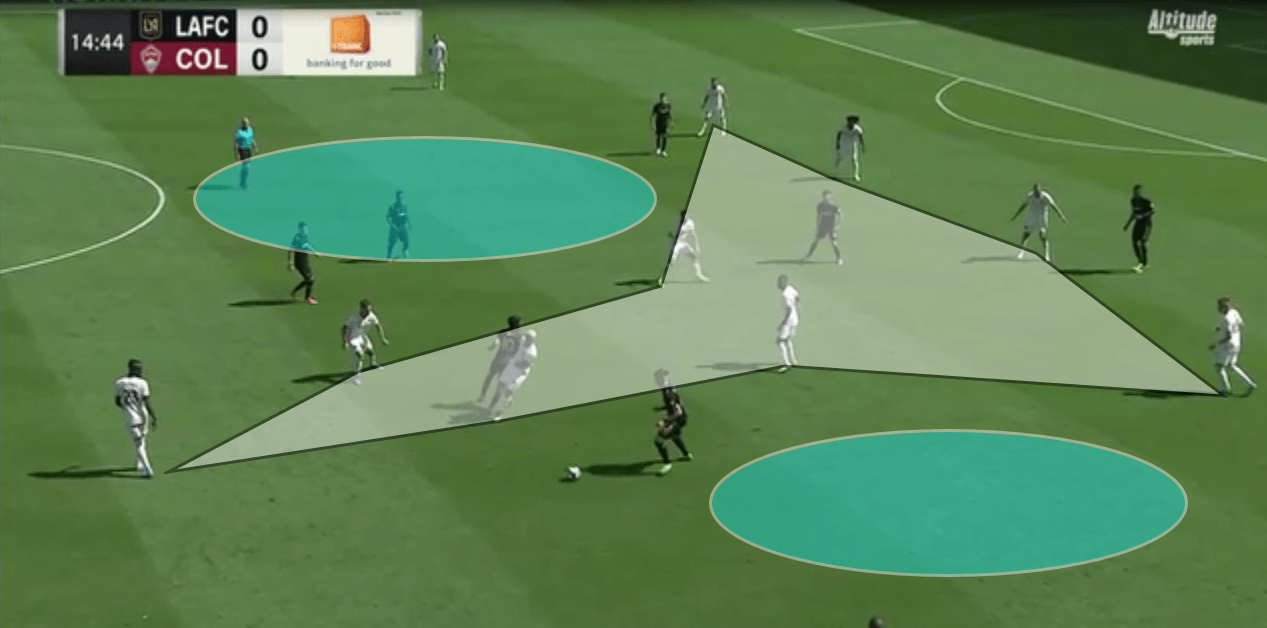
Vela moves inside as dictated by Bradley’s tactics for forwards to be flexible and as such, draws the formation inwards. Notice that space has been created in the half-spaces of the pitch. We see the half-space to the left being occupied by two LAFC central midfielders – as dictated by Bradley’s coaching – and as a result, LAFC will choose to start their attack from the left.
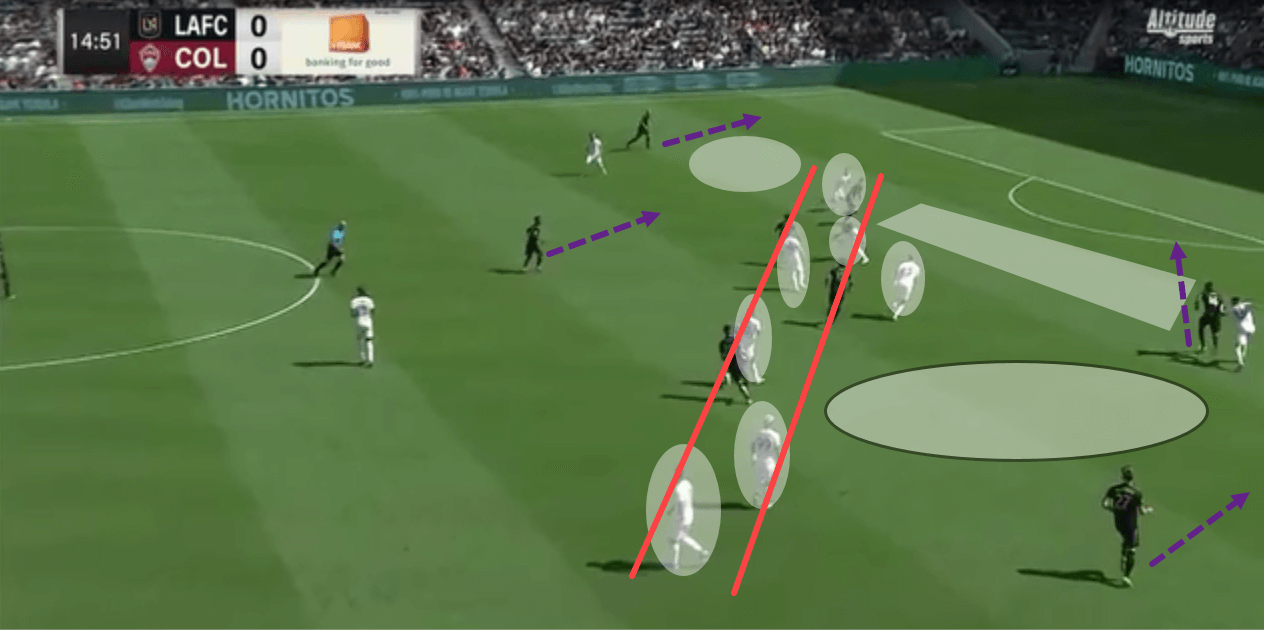
Now the ball has been moved upwards and the whole opposition formation is now confined in a very narrow and awkward position. This has created space between the full-backs, the centre-backs, and behind the defence. With chaos ensuing, LAFC will now administer organization by releasing runners into the spaces.
There are four spaces where LAFC can attack. With these runs happening at the same time, the opposition team is overwhelmed and can do nothing but defend to the best of its ability.
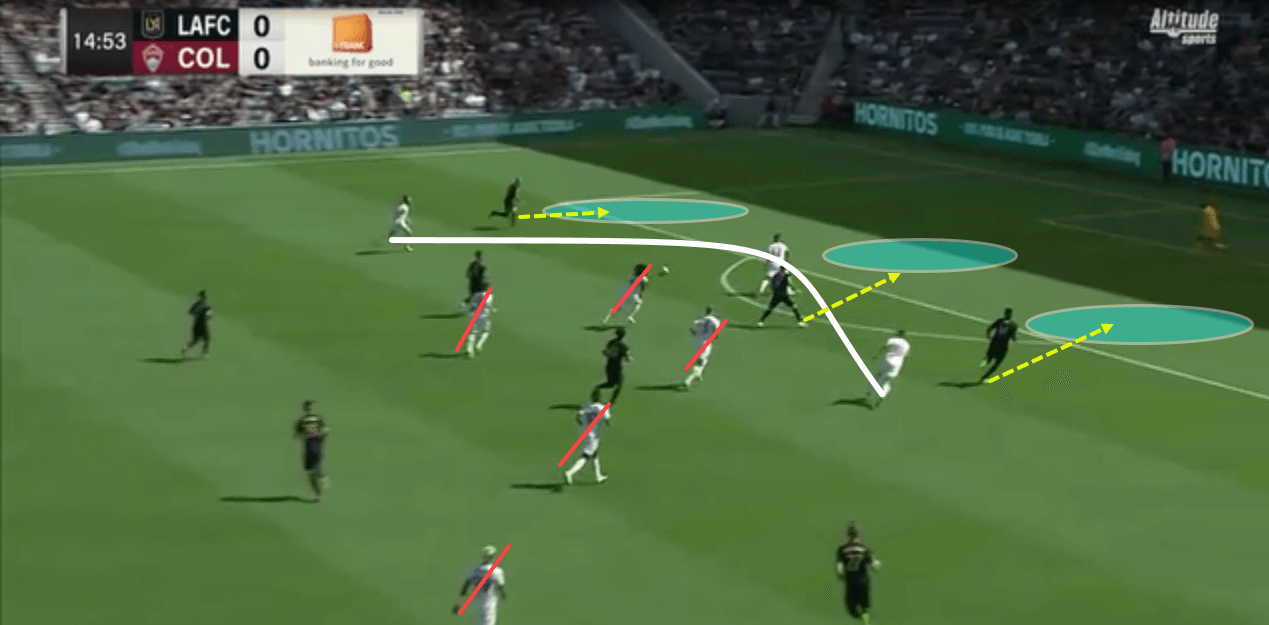
This is the final result of LAFC’s attack. The majority of LAFC’s team has been left behind and the opposition team’s defence has three glaring holes – one in the left half-space, one in the centre, and one in the right half-space.
Bradley’s “organised chaos” also means that there are three runners running at these three spaces at the same time making it incredibly hard for the defenders to know what to defend.
Bradley’s defensive tactics secure security for LAFC
LAFC conceded only 37 goals during their last season. Conceding an expected value of 1.15, LAFC’s statistic was very low compared to the league’s average which was 2.49 goals. So what were Bob Bradley’s tactics that allowed LAFC to keep such consistent defensive form?
The central tenet to LAFC’s defensive tactics is to block passing lanes and spaces in the centre of the pitch as to force the opponent to either be dispossessed or the attack switch to the wing-side.
There, LAFC utilise the profiles of their squad to create 2v1 situations on the wings. This discourages attacks on the wing and forces the opponents to switch and restart again.
To execute this tactic, it is the midfield that does the heavy-lifting for LAFC’s defensive tactics. Without possession, the 32-52 line up in a 4-4-2 with a modified midfield. The lone central defensive midfielder sits deeper making the block of four into a block of three behind the two-forward line.
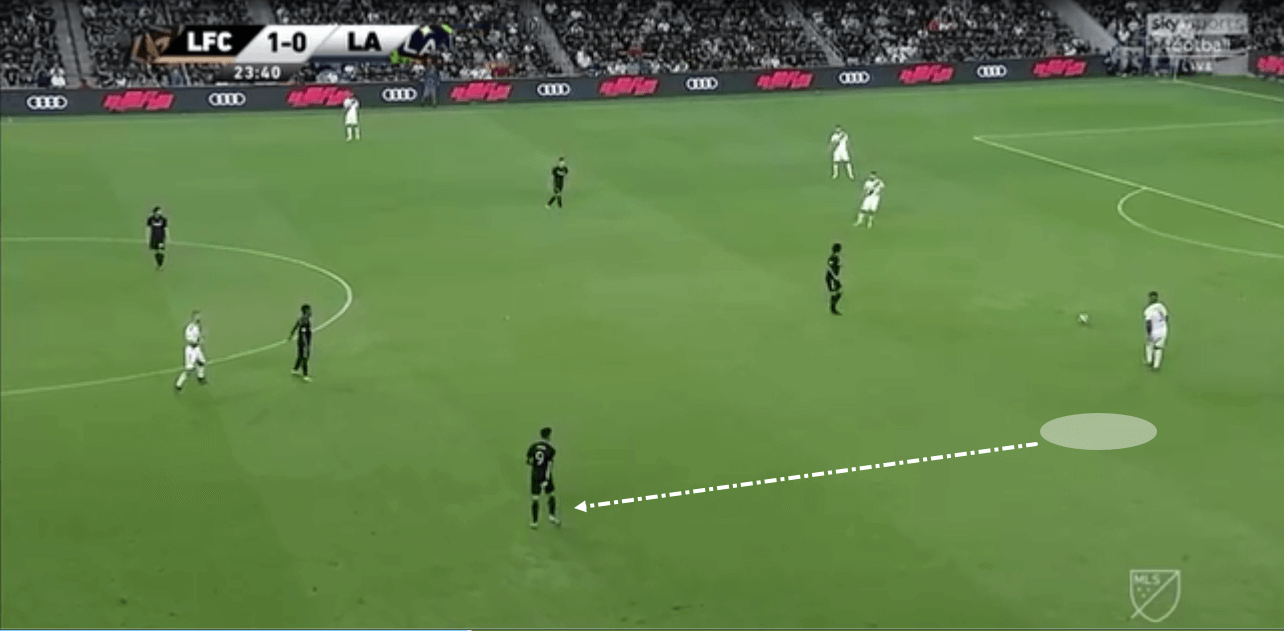
Here, Rossi drops from his forward positioning to be a part of the midfield line. We can see two members of the three-man midfield. The last midfielder, the central defensive midfielder, lies right behind this midfield line. This was the modified 4-4-2 with how Bradley set up LAFC in defence.
The first job of the midfield, and of the 4-4-2 of LAFC, is to continually apply pressure to opponents. This ranges from pressing when the opponent is in their half to applying pressure when the opponent is parked in LAFC’s attack.
The main trigger for applying pressure is when play starts to develop centrally. The fear of Bradley is that LAFC’s often forward-thinking squad will get pulled in if the play is allowed to occur centrally which will then lead to the creation of holes in the defence.
The lone central defensive midfielder does not apply that much pressure. Rather, Bradley has the defensive midfielder sit near the defence. This is yet another tactic to prevent LAFC being exposed centrally where there is the most space and time to attack.
It is the two other central midfielders, normally Blessing and Kaye, that do the dirty work of continuously applying pressure and not giving a lot of time to players deep in LAFC’s central zone. Helping this pressing action is a forward, more often than not Rossi, who becomes a temporary midfielder and adds numbers in the midfield.
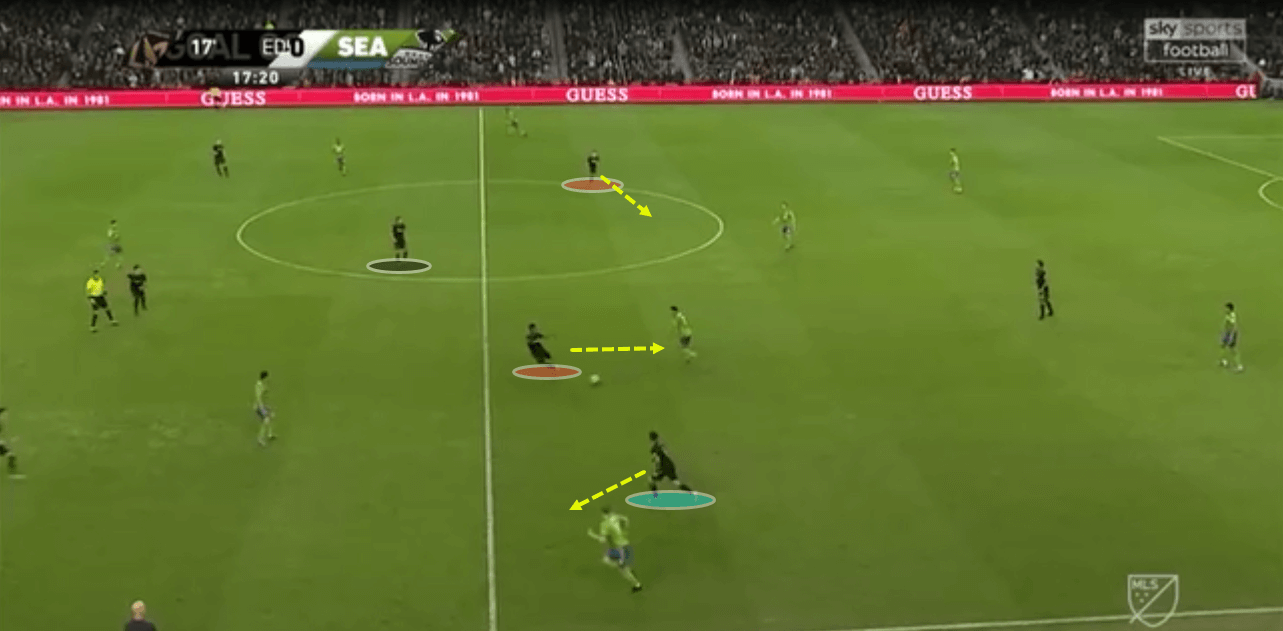
Here we see the pressing from LAFC’s midfield. The defensive midfielder sits behind the midfield, adding more central protection to the defence.
We can see the midfield three pressing the opposition players as the play moves into the central areas. Pressing like this prevents the opposition team from getting time and space in LAFC’s central zones. This forces the opposition team to hurry the play and as such, not be able to develop a good rhythm for the attack.
In addition, LAFC’s modified 4-4-2 is normally compact, not strict like blocks of Seattle Sounders but nonetheless adequately compact. With the majority of the defence camped in the centre, passing lanes in the central corridor are few in number. The opposition, as a result, ends up switching over to the wings.
Here, Bradley utilises the industrious nature of his forwards and asks his attackers deep as to pair up with the full-back. This creates a 2v1 or 2v2 causing wing attacks to nullify to a great extent. Bradley’s secondary motive with this tactic is to position his forwards in areas where they are much more likely to gain possession of the ball and start counterattacks.
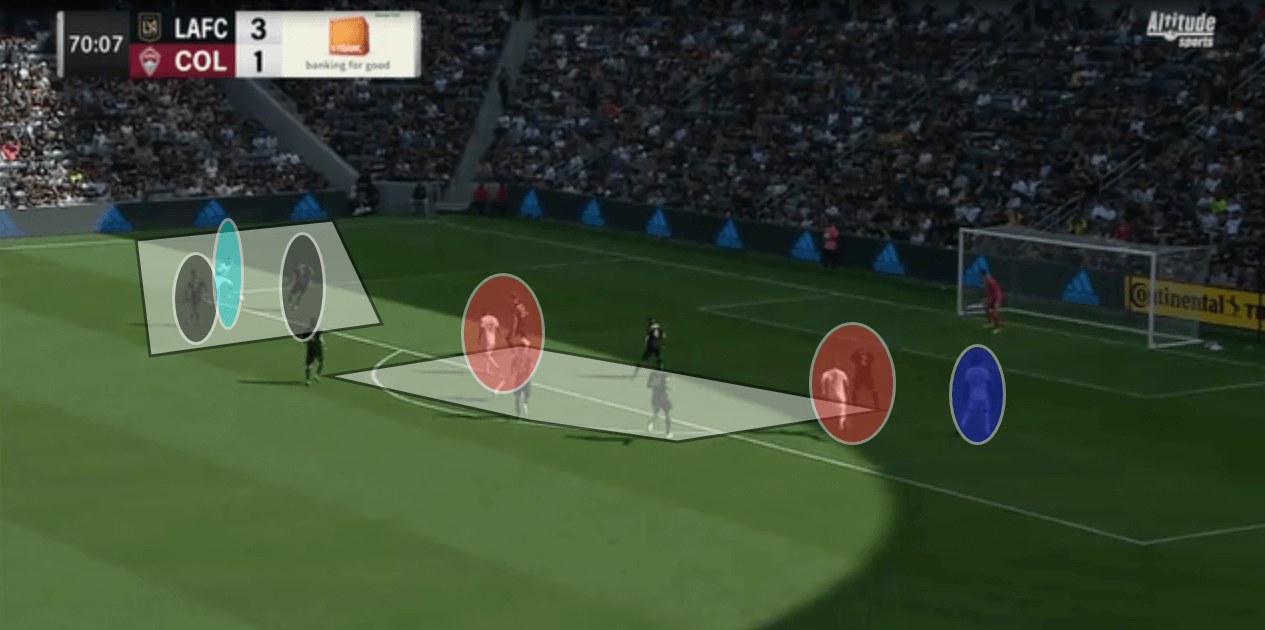
Here we see what Bradley’s defensive tactics can lead to. The tactics have lead to a 2v1 scenario on the wing areas and as such, makes it impossible for the team to make a good attack from the wing.
Additionally, LAFC have numerical superiority in the centre with the 32-52 marking two opposition players. Here, one player is left free and while normally this player would be dangerous, the creation of a 2v1 means that the LAFC defence does not need to worry about him as much.
This tactic is effective as LAFC face 9.85 shots against with the league average being 16.54 shots. With only 41% of shots, for both LAFC and league average, being on target, LAFC will face only 4 shots on target per game compared the MLS’ average of 6.78 shots. Differences like these accumulate over game and LAFC not only get better but more intelligent about defending.
Bradley’s weaknesses in his structural attacking tactics
One of the main critiques of LAFC has been their inability to break through five-man defences and low-blocks.
The main problem that five-man defences and low-blocks, in general, crowd the centre of the pitch. In a five-man defence, the five defenders are able to crowd the centre, with the help of the midfield, such that LAFC are not able to create the numerical superiority.
The same scenario occurs in the low-block were the proximity of the defence and midfield of an opposition team is very close and as such, the centre is yet again crowded.
Another problem that these teams produce is their unwillingness to shift and widen their formation. LAFC rely on the knowledge that their expansive system, coupled with their central possession play, will create holes in the formation and have opportunities to create 1v1s.
Five-man defence are quite adept at defending wing scenarios and are able to shift their formation in a manner that doesn’t open up spaces in their formation. Since they have a five-man defence, holes are quickly plugged.
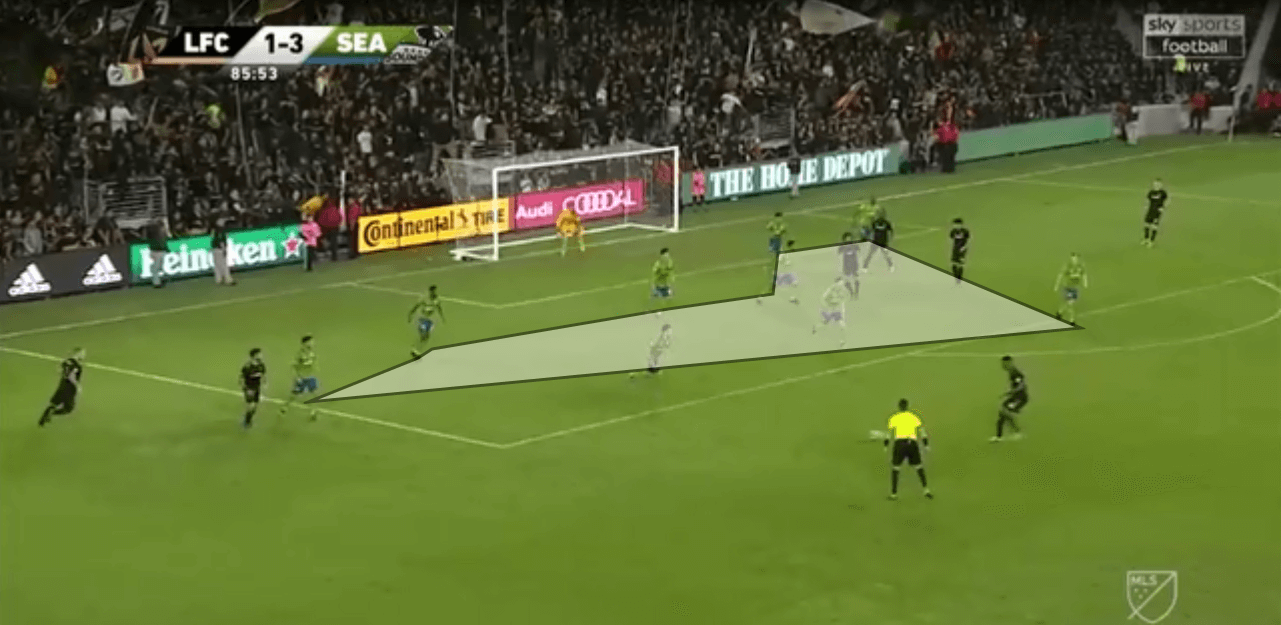
Here we see a 5-3-2 defence from the opposition. As one can clearly see, the opposition has flooded their central zone with as many players making it impossible for the LAFC forwards to find space, let alone try creative passes.
Moreover, since there are so many people, the opposition do not need to move if LAFC move their play to the wide. As such, LAFC are unable to find advantageous positions and try for more less-systematic attacks like skilful interplay. However, the more of these that LAFC make, the higher they lose the ball allowing the opposition team to hit Bradley’s men on a deadly counter.
Low-blocks, on the other hand, are normally highly disciplined and their whole defensive structure relies on moving as a unit. Additionally, low-blocks allow teams to attack through the wings. However, due to the central presence and the ability of low-blocks to control the type of play, chances from the wing areas are not as high quality they can be.
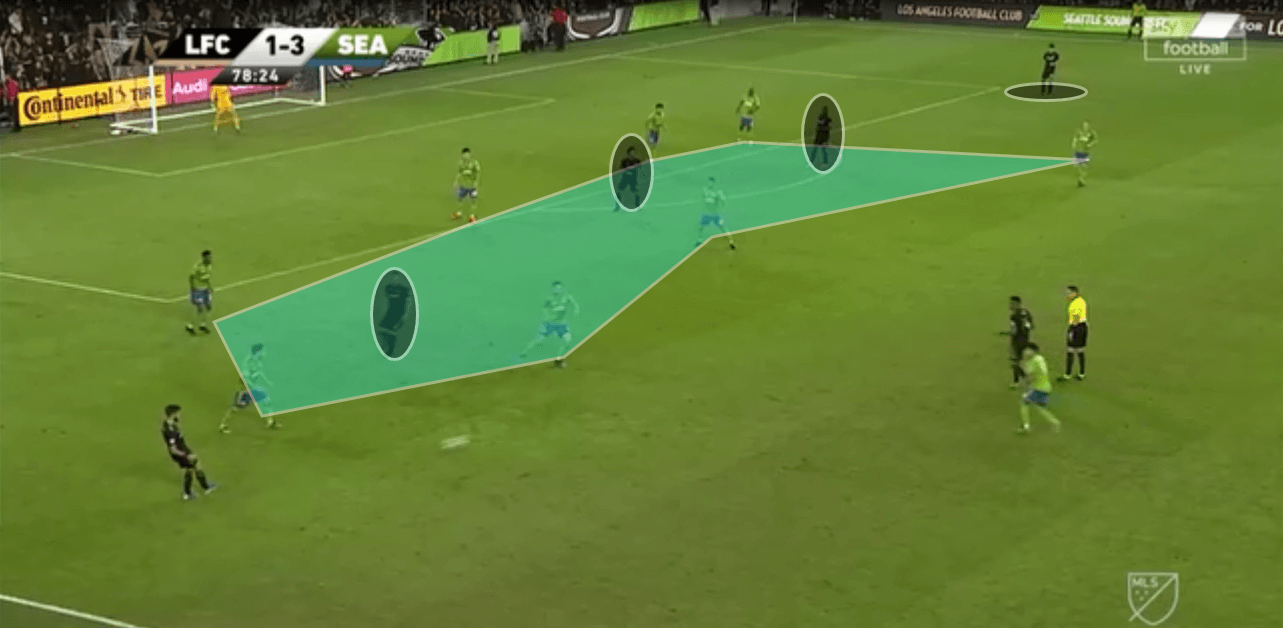
Here we see a low-block defending LAFC. One can see how tight the defensive and midfield lines. There are three LAFC players but they have very little space as the tightness means that either the midfield or defensive line can collapse on the attackers.
Moreover, since the low-block defends as a unit, LAFC cannot find an advantageous situation on the wing which is why Rossi passes back in this picture.
As such, LAFC often struggle against these teams. More often than not, these teams are happy to let LAFC control possession knowing that their central presence will not allow LAFC to play their game-plan.
The four losses that LAFC sustained, LAFC lost three of them with either a five-man defence or a low block. Additionally, a lot of the draws that LAFC sustained also had these types of teams. The most successful teams were Toronto FC and Seattle Sounders FC.
While their record was effortless, LAFC’s weakness came head to head against Seattle Sounders in their campaign to win the trophy. Seattle Sounders held back, maintained good aggression, and were sharp at every turn. The result was a 3-1 victory for the Sounders and the illustrious campaign of LAFC coming to a halt.
Conclusion
Bob Bradley’s latest stint at LAFC has truly brought out his principles and what the American coach can do with the right environment.
With an expanding MLS, Bradley and LAFC will have to put their thinking caps on to become even better as they seek to how to defeat low-blocks and their tactics. However, for MLS, Bradley’s tactics will certainly be a big obstacle to overcome.





Comments